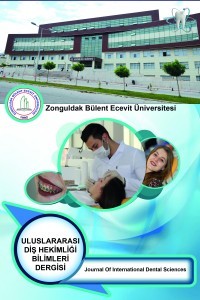Travmaya Uğramış İmmatür Maksiler Daimi Ön Kesici Dişin Pulpa Revaskülarizasyonu: Bir Olgu Raporu
Açık apeks, Revaskülarizasyon, Travma
Pulp Revascularization of a Traumatized Immature Maxillary Permanent Central Tooth: A Case Report
Open apex, Revascularization, Trauma,
___
- 1. Andreasen JO, Ravn JJ. Epidemiology of traumatic dental injuries to primary and permanent teeth in a Danish population sample. Int J Oral Surg 1972;1:235- 239.
- 2. Bastone EB, Freer TJ, McNamara JR. Epidemiology of dental trauma: a review of the literature. Aust Dent J 2000;45:2-9.
- 3. Canakci V, Akgül HM, Akgül N, Canakci CF. Prevalence and handedness correlates of traumatic injuries to the permanent incisors in 13-17-year-old adolescents in Erzurum, Turkey. Dent Traumatol 2003;19:248-254.
- 4. Tapias MA, Jiménez-García R, Lamas F, Gil AA. Prevalence of traumatic crown fractures to permanent incisors in a childhood population: Móstoles, Spain. Dent Traumatol 2003;19:119-122.
- 5. Witherspoon DE. Vital pulp therapy with new materials: new directions and treatment perspectives-permanent teeth. J Endod 2008;34:S25-28. 6. Rafter M. Apexification: a review. Dent Traumatol 2005; 21:1-8.
- 7. Katebzadeh N, Dalton BC, Trope M. Strengthening immature teeth during and after apexification. J Endod 1998;24:256-259.
- 8. Waterhouse PJ, Whitworth JM, Camp JH, Fuks AB. Chapter 23, Pediatric endodontics: endodontic treatment for the primary and young permanent dentition. In: Hargreaves KM, Cohen S. Cohen’s Pathways of the pulp. 10th ed. St Louis: Mosby Elsevier; 2011. p808-857.
- 9. Yamauchi N, Yamauchi S, Nagaoka H, Duggan D, Zhong S, Lee SM, Teixeira FB, Yamauchi M. Tissue engineering strategies for immature teeth with apical periodontitis. J Endod 2011;37:390-397.
- 10. Tronstad L, Mjör IA. Capping of the inflamed pulp. Oral Surg Oral Med Oral Pathol 1972;34:477-485.
- 11. Swift EJ Jr, Trope M. Treatment options for the exposed vital pulp. Pract Periodontic Aesthet Dent 1999;11:735- 739.
- 12. Kakehashi S, Stanley HR, Fitzgerald RJ. The effects of surgical exposures of dental pulps in germ-free and conventional laboratory rats. Oral Surg Oral Med Oral Pathol 1965;20:340-349.
- 13. Trope M. Chapter 36, Endodontic considerations in dental trauma. In: Ingle JI, Bakland LK, Baumgartner JC. Ingle’s Endodontics. 6th ed. Hamilton: BC Decker Inc; 2008. p1330-1357.
- 14. Andreasen JO, Farik B, Munksgaard EC. Long-term calcium hydroxide as a root canal dressing may increase risk of root fracture. Dent Traumatol 2002;18:134-137.
- 15. Holden DT, Schwartz SA, Kirkpatrick TC, Schindler WG. Clinical outcomes of artificial root-end barriers with mineral trioxide aggregate in teeth with immature apices. J Endod 2008;34:812-817.
- 16. Cvek M. Prognosis of luxated non-vital maxillary incisors treated with calcium hydroxide and filled with guttapercha. A retrospective clinical study. Endod Dent Traumatol 1992;8:45-55.
- 17. Ding RY, Cheung GS, Chen J, Yin XZ, Wang QQ, Zhang CF. Pulp revascularization of immature teeth with apical periodontitis: a clinical study. J Endod 2009;35:745- 749.
- 18. Thibodeau B, Teixeira F, Yamauchi M, Caplan DJ, Trope M. Pulp revascularization of immature dog teeth with apical periodontitis. J Endod 2007;33:680-689.
- 19. Hargreaves KM, Geisler T, Henry M, Wang Y. Regeneration potential of the young permanent tooth: what does the future hold? J Endod 2008;34:S51-56.
- 20. Petrino JA, Boda KK, Shambarger S, Bowles WR, McClanahan SB. Challenges in regenerative endodontics: a case series. J Endod 2010;36:536-541.
- 21. Hoshino E, Kurihara-Ando N, Sato I, Uematsu H, Sato M, Kota K, Iwaku M. In-vitro antibacterial susceptibility of bacteria taken from infected root dentine to a mixture of ciprofloxacin, metronidazole and minocycline. Int Endod J 1996;29:125-130.
- 22. Windley W 3rd, Teixeira F, Levin L, Sigurdsson A, Trope M. Disinfection of immature teeth with a triple antibiotic paste. J Endod 2005;31:439-443.
- 23. Cehreli ZC, Isbitiren B, Sara S, Erbas G. Regenerative endodontic treatment (revascularization) of immature necrotic molars medicated with calcium hydroxide: a case series. J Endod 2011;37:1327-1330.
- 24. Chueh, L. H., Ho, Y. C., Kuo, T. C., Lai, W. H., Chen, Y. H. M., & Chiang, C. P. (2009). Regenerative endodontic treatment for necrotic immature permanent teeth. Journal of endodontics, 35(2), 160-164.
- 25. Siqueira, J. F. (2001). Strategies to treat infected root canals. CDA, 29(12), 825-838.
- 26. Banchs F, Trope M. Revascularization of immature permanent teeth with apical periodontitis: new treatment protocol? J Endod 2004;30:196-200.
- 27. Thibodeau B, Trope M. Pulp revascularization of a necrotic infected immature permanent tooth: case report and review of the literature. Pediatr Dent 2007; 29:47-50.
- 28. da Silva LA, Nelson-Filho P, da Silva RA, Flores DS, Heilborn C, Johnson JD, Cohenca N. Revascularization and periapical repair after endodontic treatment using apical negative pressure irrigation versus conventional irrigation plus triantibiotic intracanal dressing in dogs’ teeth with apical periodontitis. Oral Surg Oral Med Oral Pathol Oral Radiol Endod 2010;109:779-787.
- 29. Wang X, Thibodeau B, Trope M, Lin LM, Huang GT. Histologic characterization of regenerated tissues in canal space after the revitalization/revascularization procedure of immature dog teeth with apical periodontitis. J Endod 2010;36:56-63.
- ISSN: 2149-8628
- Yayın Aralığı: Yılda 3 Sayı
- Yayıncı: Zonguldak Bülent Ecevit Üniversitesi
Kübra DEĞIRMENCI, Ayşe KOÇAK BÜYÜKDERE
Ortodonti ve Gülümseme Estetiği
Çağla BÖREKÇİ, Nurhat ÖZKALAYCI
Ecehan HAZAR, Baran Can SAĞLAM, Ahmet HAZAR
Rotasyona Uğramış Üst Santral Kesici Dişi ve Gömülü Dişi Olan Hastanın Tedavisi: Olgu Sunumu
Astım Hastalığı ve Çocuklarda Ağız Diş Sağlığı*
Mustafa TAŞKIN, Ebru HAZAR BODRUMLU
Komplike Kron Kök Kırığı Bulunan Dişlerin Reataçman Tekniği Kullanılarak Multidisipliner Tedavisi
Ata Hikmet TIMUR, Taha ÖZYÜREK, Umut MISILLI
Gömülü Santral Dişlerin Sürdürülmesinde İki Farklı Teknik ile Tedavi Edilen İki Olgu
Fethiye ÇAKMAK ÖZLÜ, Hakan YILMAZ, Engin YILDIRAN, M İnanç CENGİZ, Akif TURER
Sürmemiş Odontomaların Konik Işınlı Bilgisayarlı Tomografi CBCT İle İncelenmesi
Gökhan GÜRLER, Çağrı DELİLBAŞI, Kader AYDIN
Farklı Renkteki Rezin Simanların CAD/CAM Seramiklerin Rengine Etkisi-Pilot Çalışma
Şeyda ADIGÜZEL, Neslin VELİOĞLU, Seda CENGİZ, Selçuk ORUÇ
